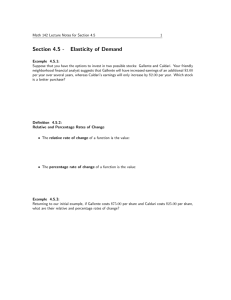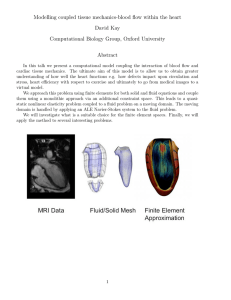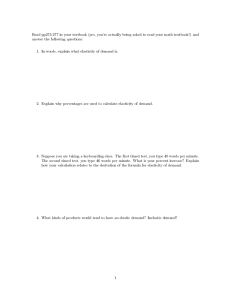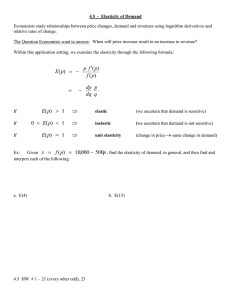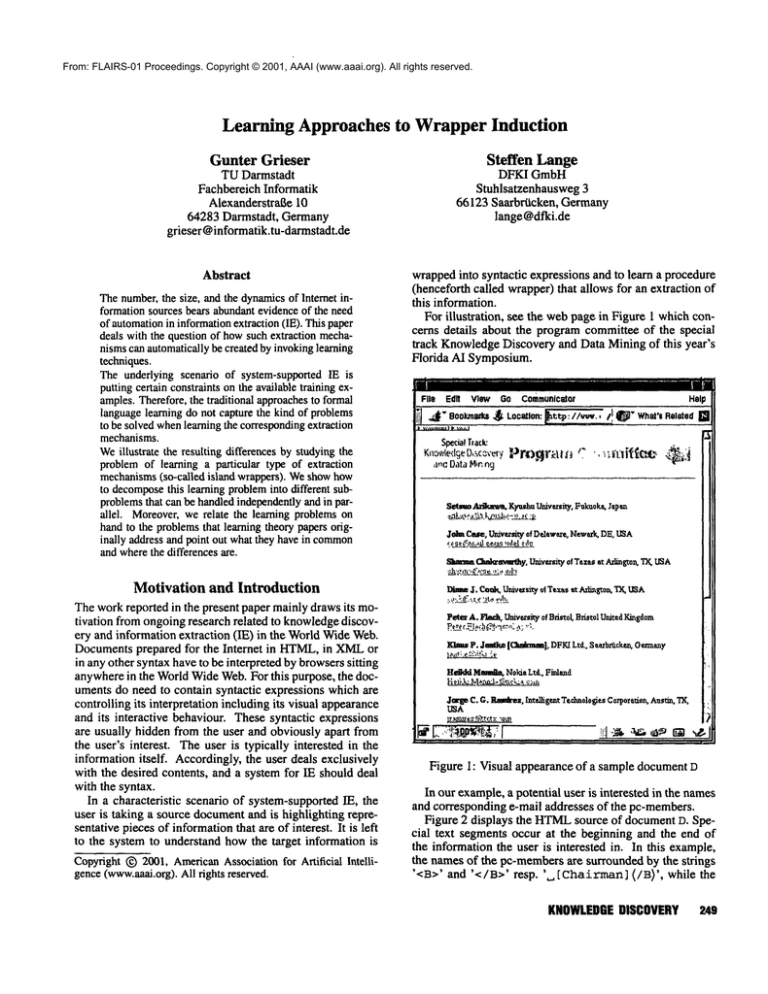
From: FLAIRS-01 Proceedings. Copyright © 2001, AAAI (www.aaai.org). All rights reserved.
Learning Approaches to Wrapper Induction
GunterGrieser
Steffen Lange
TU Darmstadt
Fachbereich Informatik
AlexanderstraBe 10
64283 Darmstadt, Germany
grieser @informatik.tu-darmstadt.de
DFKI GmbH
Stuhlsatzenhausweg 3
66123 Saarbriicken, Germany
lange@dfki.de
Abstract
Thenumber,the size, and the dynamicsof lntemetinformationsourcesbears abundantevidenceof the need
of automation
in informationextraction(IE). Thispaper
deals with the questionof howsuch extraction mechanismscan automaticallybe createdby invokinglearning
techniques.
The underlying scenario of system-supportedIE is
puttingcertain constraintsonthe availabletraining examples.Therefore,the traditional approachesto formal
languagelearning do not capture the kind of problems
to be solvedwhenlearningthe corresponding
extraction
mechanisms.
Weillustrate the resulting differencesby studyingthe
problemof learning a particular type of extraction
mechanisms
(so-called island wrappers). Weshowhow
to decompose
this learningprobleminto different subproblemsthat can be handledindependentlyand in parallel. Moreover,we relate the learning problemson
handto the problemsthat learningtheory papersoriginally addressand point out whatthey havein common
and wherethe differencesare.
Motivationand Introduction
The work reported in the present paper mainly drawsits motivation from ongoingresearch related to knowledgediscovery and information extraction (IE) in the WorldWideWeb.
Documentsprepared for the Internet in HTML,in XMLor
in any other syntax haveto be interpreted by browserssitting
anywherein the WorldWideWeb.For this purpose, the documents do need to contain syntactic expressions which are
controlling its interpretation including its visual appearance
and its interactive behaviour. These syntactic expressions
are usually hidden from the user and obviously apart from
the user’s interest. The user is typically interested in the
information itself. Accordingly, the user deals exclusively
with the desired contents, and a system for IE should deal
with the syntax.
In a characteristic scenario of system-supportedIE, the
user is taking a source documentand is highlighting representative pieces of informationthat are of interest. It is left
to the system to understand howthe target information is
Copyright(~) 2001, American
Associationfor Artificial Intelligence(www.aaai.org).
All rights reserved.
wrappedinto syntactic expressions and to learn a procedure
(henceforth called wrapper)that allows for an extraction
this information.
For illustration, see the webpage in Figure 1 whichconcerns details about the programcommittee of the special
track KnowledgeDiscovery and Data Mining of this year’s
Florida AI Symposium.
File
Edit
VIeW GO Communlc~or
Help
SpecialTrack:
,t.c D,~t,~H,nng
SetmmAra~mwa.
K)~shu Umwzsiu/,F~akuoke, l,pen
Jo~n Cue, Univ~rsity of Delaware.New.k. DE, USA
Otsl~ml~thy,University of Tsxa~at Arlington, ’IX, USA
~. Cook,Umv~siV]
o~ Ttxas at J~li~gr~a, TYs,USA
:,,?>.~’i(.
’,’~..~
:j.t,,::!!?.~.
Pete~A. Fl.a~, Uaivtrsityof Bristol,Bristol UnitedKingdom
~tZU.~!~b~’~’~"
.a:. ~-’,.
Elms P. J~tl~ [Gmkmm],
DFKILtd., S a~rbr&cke.--,t, Germany
Hm~ldMmmm~t,
N0kia Ltd., Finlead
Jm’se C. G. Rmairu, lntdlig~t Teelm01o~iesC orpoze.don, Aasdn, IX,
USA
, ,,i
,
,
..,
,,
,
,
::
|~
Figure 1: Visual appearance of a sample documentD
In our example,a potential user is interested in the names
and corresponding e-mail addresses of the pc-members.
Figure 2 displays the HTML
source of documentD. Special text segments occur at the beginning and the end of
the information the user is interested in. In this example,
the namesof the pc-membersare surrounded by the strings
’<R>’ and ’</B>’ resp. ’~ [Chairman] (/B)’, while the
KNOWLEDGE
DISCOVERY 249
email addresses aresurrounded by thestrings ’~d~ILTO:’
and .... . These delimiters mayguide an extraction procedure to recognize the correct informationpieces.
Figure 2: HTML
source of D
Figure 3 shows the PROLOG-Iike(cf. (Grieser et aA
2000)) representation of a wrapperwhich allows for the extraction of all pairs (N, E) in documentD, where N is pcmember’snameand E is the corresponding e-mail address.
o) extract(N, E, Xx (B)NRxX~MAILTO
: E" X3)
not c-rx(N), n(RD,not c-la(Xz), not c-rg.(E).
(z) rl((/B)).
(3)rx (,., [Chairman]
(/B)).
(~)c-rl(X)+-- rt(X).
(oc-rl(XY) ~ c-q (Y).
(s)c-rt(XY) ~ c-r~(X).
(7) c-12(MAI
LTO: ).
(a)c-I~(XY)~- c-12(X).
(9)c-lz(XY)+-- c-19(Y).
.o)c-r~(").
(,2) c-rg.(XY)
+-- c-rg.(Y).
~,)c-r2(XY) ~ c-r2(X).
Figure 3: Anappropriate extraction procedure for D
The first rule can nowbe interpreted as follows. A pcmember’s name N and the corresponding e-mail address E
can be extracted from an HTML
documentin case that (i)
matches the pattern ’X~ (B)NR~XzMAILTO
: E" Xa’ and (ii)
the instantiations of the variables N, R~, Xz, and E meetcertain constraints. For example,the constraint r~ (R~) states
that the variable R~ can only be replaced by somestring
’(/B)’ or ’,., [Chairman] (/B)’. Further constraints
’not c-2~ (Xg.) ’ explicitly state which text segmentsare
not suited to be substituted for the variable Xz. This particular constraint guaranteesthat the specified wrapperdoes not
allow for the extraction of pairs (N, E) such that the name
250
FLAIRS-2001
N and the e-mail address E belong to different pc-members.
The other two constraints ’not c-r~ (N) ’ and ’not
rz (E) ’ ensure that the strings substituted for Nand E, respectively, are as short as possible. Finally, if D matches
the pattern ’X~ (B)NR~Xg.MAILTO
: E" X3’ and all the constraints are fulfilled, then the instantiations of the variables
N and E yield the information required.
This paper deals with the question of howsuch extraction
mechanismscan automatically be created by invoking learning techniques. On a first glance, wrapperinduction seems
to be a particular instance of the more general problemof
language learning from positive examples. However, the
problemon hand has its special features. The information,
which a potential user provides, does not meet the standard
assumptionsunderlying almost all theoretical approachesin
formal language learning.
It is the aim of the present paper to makethis difference more explicit. Moreover,we relate the learning problems on hand to the problems that learning theory papers
originally address and point out what they have in commonand where the differences are. More specifically, we
use the problem of learning island wrappers, a particular simple class of wrappers introduced in (Thomas1999a;
1999b),as an illustrating example.
Ourtheoretical investigations are basedon the rather idealistic asumptionthat, whenlearning any particular island
wrapper, thelearner eventually receives all HTML
documentstogether with the overall set of informationthat can be
extracted from those documentsby meansof this particular
wrapper. Naturally, one has to be awarethat problemswhich
can be identified whenstudying the principal capabilities of
algorithmic learners under this idealistic assumptionhave to
be considered whendesigning applicable algorithms for automatic wrapperinduction in cases where these assumptions
do not hold.
Gold-Style LanguageLearning
In this section, we provide the basic concepts of Gold’s
(1967) modelof learning in the limit.
Let ~ be any finite alphabet. By E* we denote the set of
all strings over E. Welet ~+ = E* \ {e}, where e denotes
the emptystring.
Anysubset L C_ E* is called a language. Next, for any
L,L’ C_ E*, weletLoL’ = {wv I w 6 L, v 6 L’).
~, = ~* \ (~* o L o Z*), and ~+ = Z~, \
A class of non-emptylanguages C is said to be an indexable class of recursive languages(indexable class, for
short), if there is an effective enumeration(L~)~e~of
and only the languages in C such that membershipis uniformly decidable with respect to this enumeration(cf. (Angluin 1980)). Subsequently, an enumerationof this kind
said to be an indexingof C.
Angluin(1980) started the systematic study of learning
indexable classes. (Angluin 1980) and succeeding publications (cf. (Zeugmann
&Lange1995), for an overview) found
a lot of interest, since mostnatural languageclasses constitute indexableclasses.
There are several ways to present information about formal languages to be learned. The basic approaches are defined via the concepts text and informant, respectively. A
text is just any sequenceof wordsexhausting the target language. Aninformant is any sequence of words labelled alternatively either by I or 0 such that all the wordslabelled by
1 form a text for the target languageL, whereasthe remaining words labelled by 0 constitute a text of the complement
of L. In all what follow, we exclusively deal with the case
of learning from text.
Analgorithmic learner (henceforth, called IIM) receives
as inputs larger and larger initial segmentsof a text t for a
target language L and generates as its outputs hypotheses.
AnIIM learns a target language L from text t, if the sequenceof its outputs stabilizes on a hypothesisthat correctly
describes L. Now,an IIM is said to learn L from text, if it
learns L from every text for it. Furthermore, somelanguage
class C is said to be learnable from text, if there is an IIM
which learns every language L E C from text. By LimTxt
we denote the collection of all indexableclasses C for which
there is an IIMthat learns C fromtext.
The collection of all Lira Txt-identifiable classes can be
characterizedin termsof finite ’tell-tale sets’.
Theorem1 (Angluin 1980) Let C be an indexable class.
C E LimTxt iffthere are an indexing (Lj)je~ of C and
procedurep that, given any j E ]N, enumeratesa finite set
Sj suchthat (i) and(ii) are fulfilled, where
(i)for all j E IN, Sj C Lj.
(ii)forall j, k E IN, ifSj C Lk then Lk ~- Lj.
Island Wrappers
Next, we define a particular type of wrappers, so-called island wrappers (of. (Thomas1999a; 1999b)), that describe
a particular way of how interesting information may be
wrapped into an HTML
document. This approach rests upon
the following assumptions.
(i) Informationof the sametype visually appears in the same
style in a documentand, vice versa, the visual appearance
allows for grouping information.
(ii) The visual appearanceof information has to be encoded
in a document,and therefore the correspondingtext parts
are surrounded by HTML
commandsthat in turn mayhelp
to find these text parts in the document.
Morespecifically, it is assumedthat somecorrespondingtext
part v can be identified by particular strings l and r that occur in the HTML
documentto the left and to the right of v,
respectively. The surrounding strings l and r, whichare by
no meanslimited to contain only formatting commands,are
called delimiters. Thetext part lvr is said to be an island.
Island wrappersgeneralize this basic approach by specifying of how interesting n-tuples (vl,...,vn)
may be
wrapped into HTML
documents. Here, the corresponding
left and right delimiters are not uniquelyfixed. In contrast,
they maybelong to possibly infinite languagesof admissible
delimiters (so-called delimiter languages). As we see below,
a particular island wrapperis uniquely characterized by its
delimiter languages.
In general, given any documentd E E+, an island wrapper Wmaybe understood as a finite description of a mapping that assigns a finite set Sw (d) of n-tuples to d, where
Sw (d) contains all and only the n-tuples that are wrapped
into d, accordingly.
Moreformally, let n > 1, let L1, R1,..., Ln, Rn be delimiter languages, and let W= (Lx, R],... Ln, Rn) be the
corresponding island wrapper. Then, the island wrapper W
defines the following mapping Sw from documents to n_
ary relations: Given any documentd, we let Sw (d) be the
set of all n-tuples (vl,...,vn)
E (~+)n for which there
are xo E ~*,...,x,~
E ~*, 11 ELI,...,
In E Ln and
rl E RI,... ,rn E Rn such that conditions (i) to (iii)
fulfilled, where
(i) d = XollVlrl ... InvnrnXn.
(ii) for all i E {1,... ,n}, vi does not contain a substring
belongingto Ri, i.e., vi E ~+,.
(iii) for all i E { 1,..., n- 1 }, xi doesnot containa substring
belonging to Li+l, i.e., xi E ~+1"
Conditions(ii) and (iii) imply that the extracted strings
as short as possible and that the distance betweenthemis
as small as possible. This, in particular, helps to avoid that
extracted strings, whichare supposedto belong to different
n-tuples, are groupedin the samen-tuple.
Learning Island Wrappers
In this section, we deal with the problem of howto learn
wrappers from examples. In the long-term, we are interested
in learning devices that learn extraction mechanisms
implementing the mappingsdefined by the corresponding wrappers. Thelatter is oneof the central topics of a joint research
and development project named LExIKON
on information
extraction from the Internet. This project is supported by
the GermanFederal Ministry for Economicsand Technology. Besidethe authors’ institutions, the project consortium
comprises other academicresearch teams at the University
Leipzig, the University of Koblenz-Landan, and the Bayerische Hypo- und Vereinsbank AG,respectively, and the
two software houses rzw_cimdata and Dr. Stephan &Partner.
Since an island wrapperis completely determined by its
delimiter languages, the overall learning problemreduces to
the problem of finding these delimiter languages. On the
first glance, this seemsto be a particular instanceof the traditional learning problemsdescribed above. However,a potential user does not directly provide elementsof the delimiter languagesas exampleto the IE system. Instead, the user
marks interesting text parts in the HTML
documentsunder
inspection, and thus the IE systemreceives only implicit information about the delimiter languages to be learned. Consequently, the approachesdevelopedfor traditional language
learning do only translate indirectly - after an appropriate
adaptation- to the setting of languagelearning from marked
text.
The relevant details are as follows.
Now, suppose that a user marks an interesting
ntuple ~vl,... ,vn) in a document d under inspection.
KNOWLEDGE
DISCOVERY 261
Herewith, the user simultaneously marks the corresponding starting and end positions of these strings. Moreover, assuming that each vi ends before vi+l starts,
the user samples the document into 2n + 1 consecutive text parts Uo,vt,ul,...,vn,Un.
Hence, the string
uovlul "’vnun equals d. Finally, such a 2n+l-tuple
( uo, el, u l , . . . , vn, un) is said to be an n-marked
document.
Let W= (L1, R1,..., L,, R,~) be an island wrapper and
let m= (uo, vl, ul,..., vn, u,) be an n-markeddocument.
Then, mis said to be an examplefor Wif conditions (i)
(iii) are fulfilled, where
(i) u0 E ~* o L1 andu, Rno ~*.
(ii) for all i E (1,..., n}, vi E ~+,.
(iii) for all i E {1,..., n - 1}, ui E Rio Z*L~+Io Li+l.
Now,an n-markedtext t for an island wrapperWis an infinite sequence of n-markeddocumentsthat serve as examples for W.Similarly as above, it is required that t exhausts
the set of all possible examplesfor W,i.e., every n-marked
documentthat constitutes an examplefor Wmust eventually
appear.
Finally, a wrapper learner (henceforth called WlM)receives as input larger and larger initial segmentsof a marked
text for sometarget wrapperWand generates as outputs hypotheses. Learning took place iff the sequence of hypotheses stabilizes on somedescription of a wrapperW’such that
Sw(d) = Sw, (d) for all documents d E ~+.
¯ T2(L)= o {#} o L s,
Third, the subsequence(Ul~)je~, for instance, simultaneouslyprovides informationabout the right and the left delimimr language R1 and L2, respectively, since ul~ has a
prefix and a suffix belongingto R1 and L2, respectively. As
above, by definition, the n-markedtext contain somemore
information concerning both delimiter languages. Putting
everything together, one directly sees that the sequence
(vlj #uli)ja~ forms a text for a languageof type
¯ T3(L, L’) = ~+ o {#}o L o ~,, o L’.
Hence, by exploiting all the information which an nmarkedtext contains, one comesup with n + 1 different traditional problemsof learning languagesfrom ordinary text.
Moreformally, the following learning problemsare of interest.
Collection of relevant learning problems
Definition 1 Let 6~ be an indexable language class. For
all i E {0,..., 3}, the learning problem LP~(CC)can
solved iff Ti(cc) E LimTzt, where To(CC) = 6", T1(6’)
{TI(L) [L C 6’}, T2(CC) : {T2(L) I L ¯ and
T3(CC)= {T3(L, L’) I L, L’ ¯ 6,}.
Here, LPo(CC)serves as kind of master problem whenrelating the resulting learning problems/-21
(6’) till LP3(6’)
one another. Weare interested in answeringquestions like
the following: Is it possible to solve the learning problems
LP1(6’), LP~(6’) or LP3(6") providedone knowsthat there is
a solution for the problemLPo(6’)? Questionsof this kind
will intensively be studied in the next subsection.
Conceptually, whenlearning an island wrapper from marked
text, one mayproceedas follows: In a first step, the overall
learning problem has to be decomposedinto several individual learning problems. In a second step, learning algorithms have to be invoked to solve the derived individual
learning problems independently and in parallel. In a coneluding step, the solutions of the individual problemshave
to be used to determinethe defining delimiter languagesand
to fix the hypothesizedisland wrapper.
In general, there are three types of individual learning
problemsthat have to be solved.
So, let W= (L1,R1,...,Ln,R,)
be the target island
wrapperand let ((uo~, vii, ul~,..., vnj, unj))je~ be the nmarkedtext presented.
First, the subsequence (uoi)je~ provides information
about the left delimiter language L1, since every u%has
a suffix belonging to L1. However,from the IE system’s
perspective, it is by no meansclear wherethe corresponding
suffix starts in Uoi. But it is clear that (u%)j~r~formsa text
for a languageof type 1:
¯ TI(L)=Z*oL.
Second, the subsequence (Unj)je~ provides information
about the right delimiter language R,, since every Un~has
a prefix belonging to Rn. But the n-markedtext contains
some more information concerning Rn. By definition, the
strings v,~j markedby the user do not contain any substring
that belongs to Rn. To formalize this, let # be any symbol not occurring in E. Then, the sequence (v,,~ #Unj)jer~
constitutes a text for a languageof type 2:
Relations between the relevant learning problems
Westart our discussion with an illustrating example. Let
Z = {a,b,c}.Foralln ¯ ]N, letLo = {amb lrn > 1}U{c}
and Ln+l = {arab [ 1 < m < n + 1} U {c, ca}. Moreover,
we let CCA
be the collection of all these languages.
First, we consider the learning problemLP1(CCA).An appropriate IIM Mmaywork as follows.
IIM M: On input wo,..., win, check whether some of the
strings wo,..., Wraends with a. If no such string occurs,
output a description for E* o Lo. Otherwise, return a description for ~* o L1.
Obviously, Mwitnesses T1 (CCA)¯ LimTxt. Does this insight help to derive an answerto the question of whetheror
not the learning problemLP2(CCA)can be solved? The ultimate answeris no, since it turns out that T2(CCA)LimTxt.
To see this, assume the contrary, i.e., let Mbe an IIM
that learns Tg.(6’A) in the limit fromtext. First, it is easy
to see that ]~+
L~ = E+j
for anyi,j ¯ ~I. Based onM,
one can easily define an IIM M’ that LimTxt-identifies the
indexable class {L o E* ] L ¯ CCA}.Next, by Theorem1,
there is a finite set So C Lo o E* such that So C L o E*
implies L o E* ¢~ Lo o ~*, for any L ¯ CCA.For the ease
of argumentation,assumethat somestring in So has a prefix
of form an’ b. Let n be the maximalindex n’. Clearly, L, o
E* C Lo o E*. On the other hand, one directly sees that
So C_ L,~ o E*. But this contradicts our assumptions that
So serves as a finite tell-tale set for Lo, and thus T2(6’A)
L im Txt.
252
FLAIRS-2001
To sum up the discussion of our illustrating example:
Knowingthat the learning problemLPt (C) can be solved for
someindexable class C does not imply that one can solve the
learning problemLP2(C) as well.
Surprisingly, this insight generalizes as follows:
Theorem2Leti,j E {1,...,4}
withi ~ j. Then, there
is an indexable class C such that assertions (i) and (ii)
fulfilled, where
(i) it is possible to solve problemLPi(C).
(ii) it is impossibleto solve problemLPj (C).
Proof. For each relevant pair i, j, we haveto providean indexableclass that meet(i) and (ii). Dueto space constraints,
we only sketch somesimple cases.
As argued above, the learning problems LPo(CA) and
LP1 (CA) can be solved. A careful analysis showsthat the
same is true for LP3(CA), while LP2(CA) cannot be solved.
Now,let ~ = {a, b} and let CBbe the collection of the following languages Ln, where, for all n E IN, L0 = {abma[
m > 1} and Ln+l :- Lo \ {abn+la}. As it turns out, the
learning problems LPo (CB) and LP1 (CB) cannot be solved.
In contrast, the learning problems LP~(CB)and LP3 (CB)
have a solution. This is mainly due to the fact that, for
all n E IN, ~+
contains exactly one string that belongs
Ln+l
to Lo, namelythe string abn+la. This allows one to distinguish the languages7"2 (Lo) and T2 (Ln+l) as well as T3
and T~ (L~+I), respectively.
[]
Consequently,there are indexable classes C such that
(i) knowingthat there is a solution for one of the learning
problems does not help to solve the other ones and, vice
versa,
(ii) knowingthat somelearning problem cannot be solved
does not meanthat one cannot solve the other ones.
After showingthat all the learning problemsdefined are
somehow
independent, further investigations deal with the
question under what circumstances learning becomespossible. To answerthis question, we provide a kind of case study
concerning learning problem LP2 (C).
One particular
learning problem
Wright (1989, see also (Motoki, Shinohara, & Wright
1991)) introducedthe followingsufficient condition for limit
learning fromtext.
Definition 2 (Wright 1989) Let C be an indexable class.
C has infinite elasticity, if there are an infinite sequence
(wj)jE~ of strings from ~* and an infinite sequence of languages (Lj)jE~ of languagesin C such that, for all k >_1,
{w0~...,wk-1} C Lk andwk ~ Lk.
C has finite elasticity if it doesnot haveinfinite elasticity.
Theorem3 (Wright 1989) Let C be an indexable class that
hasfinite elasticity. Then, C E LimTxt.
Assumethat a given indexable class C has finite elasticity. By Theorem3, we know that t7 E LimTxt. Does this
imply T2(C) LiraTxt, aswell? If we canshowthat T2(C)
has finite elasticity as well, then we are immediatelydone.
However,this is impossible.
Theorem4 There is an indexable class C such that conditions ( i ) and( ii ) arefulfilled, where
( i) C hasfinite elasticity.
( ii ) T2( C) hasinfiniteelasticity.
Proof Let E = {a, b} and let Cc be the collection of all
languages Ln, where, for all n _> 0, Ln = {ban+lb, bb}.
It is not hard to see that Cohas finite elasticity. Tosee that
Tz (Co) has infinite elasticity, choosethe sequenceof strings
w’o = bab#bb, w’1 = baab#bb .... and the sequence of
languages L~ = T2(L1), L~ = Tg.(Lz)
[]
However,for a slight variation of the language class
T2(C), namely the class T4(C) = {L o E* I L E C},
can be shownthat T4(C)has finite elasticity in case C has
finite elasticity.
Proposition 5 Let C be an indexable class that has finite
elasticity. Then,T4( C ) hasalso finite elasticity.
Hence, T4(C) E LimTxt.
Now,the latter theorem can be invoked to show that
T2(C)LimTxtincase that C hasfini te elas ticity.
Theorem
6 Let C be an indexable class that has finite elasticity. Then, T2(C) LimTxt.
Finally, there is another, somehow
orthogonal, sufficient
condition that ensures that one can solve learning problems
of type 2.
Theorem7 Let C be an indexable class that only contains
finite languages. Then, Tz(C) LimTxt.
References
Angluin, D. 1980. Inductive inference of formal languages
from positive data. Information and Control 45:117-135.
Gold, M.E. 1967. Languageidentification in the limit.
Information and Control 14:447--474.
Grieser, G.; Jantke, K. P.; Lange, S.; and Thomas,B. 2000.
A unifying approach to HTML
wrapper representation and
learning. In Proc. Conference on Discovery Science, LNAI
1967, 50--64. Springer-Verlag.
Motoki, T.; Shinohara, T.; and Wright, K. 1991. The correct definition of finite elasticity: corrigendumto Identification of unions. In Proc. Workshopon Computational
Learning Theory, 375. Morgan KaufmannPublishers
Thomas,B. 1999a. Anti-unification based learning of TWrappersfor information extraction. In Proc. AAAIWorkshop on MachineLearning for IE, 15-20.
Thomas, B. 1999b. Logic programs for intelligent web
search. In Proc. Symposiumon Methodologiesfor Intelligent Systems, LNAI1609, 190-198. Springer-Verlag.
Wright, K. 1989. Identification of unions of languages
drawn from an identifiable class. In Proc. Workshopon
Computational Learning Theory, 328-333. Morgan KaufmannPublishers
Zeugmann,T., and Lange, S. 1995. A guided tour across
the boundaries of learning recursive languages. In Algorithmic Learning for Knowledge-BasedSystems, LNAI
961,190-258. Springer-Verlag.
KNOWLEDGE
DISCOVERY 253

